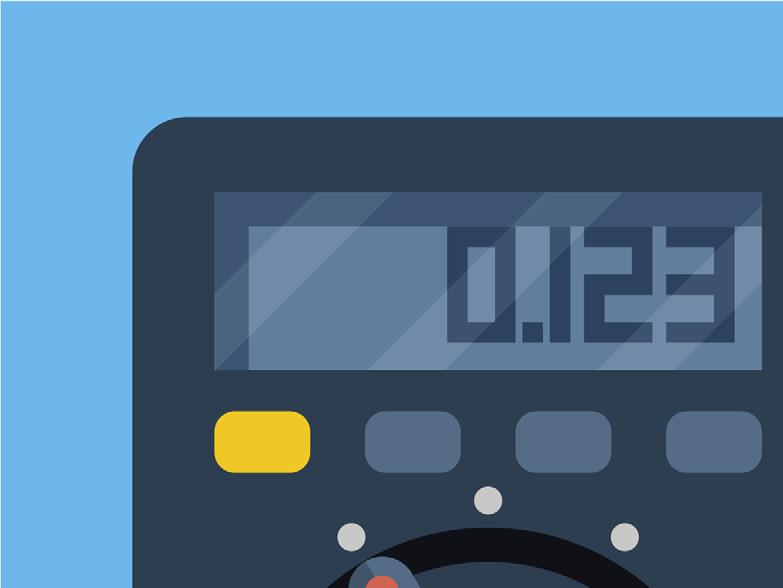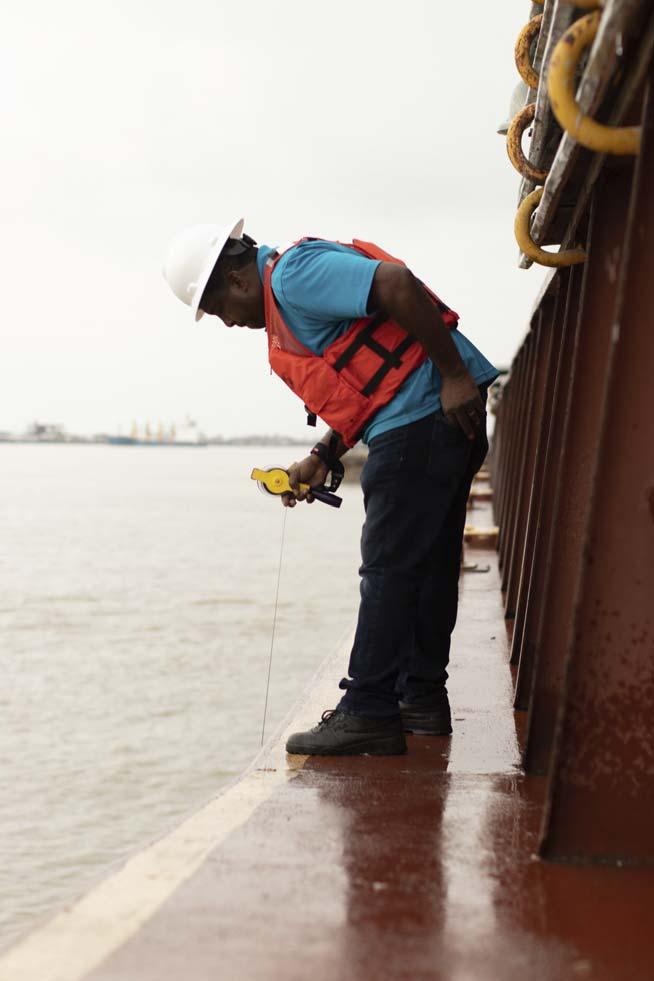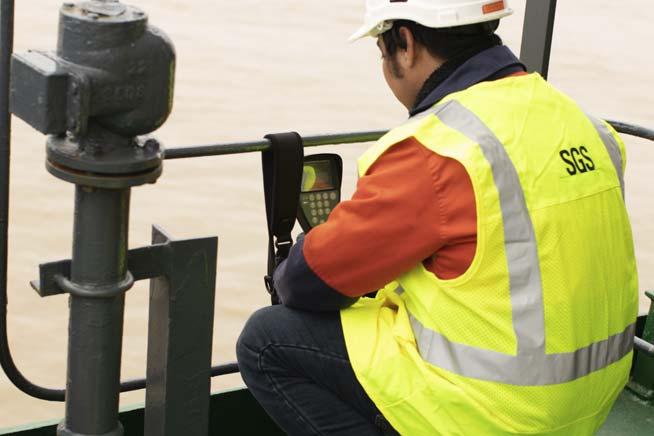
7 minute read
A More Exact Science


Pj Kwong and Teddy Katz, on behalf of SGS North America,
describe the development of a device designed to obtain more accurate draft measurements of fertilizer cargo in vessels and prevent costly disputes.


A MORE EXACT

SCIENCE
It is said that ‘necessity is the mother of invention’, which aptly describes the process that led to the development of the Draft Survey Tool (DST) and the DST Lite. The emergence of these new devices has changed the way the fertilizer industry is able to obtain draft measurements of cargo in vessels transporting their product around the globe.
Imagine, with the millions of tonnes of fertilizer being shipped on an annual basis, what an advantage it would be if inspectors could utilise modern technology to have timely and more precise measurements to remove altogether the costly and lengthy disputes common in the industry. This same technology would help the inspectors determine accurate readings of a ship’s cargo without the risks that have been part of the process for years.

As was the case for over 100 years, inspectors needing to perform a draft survey would approach a vessel and take the measurements from a small boat or by scaling down a rope ladder suspended from the deck that had been dropped up to 17 m down the side of a vessel: it paints quite the picture with an inspector at the bottom of a swaying rope ladder, trying to assess visually where the water meets the side of a hull in order to obtain the measurements. That does not even begin to cover that same inspector’s exhausting climb back up the ladder to the safety of the deck, which is equivalent to scaling a five-storey building. Very little had changed over the course of a century in the draft survey process in terms of technology or with respect to crew safety.
A draft survey could also be performed in all kinds of weather and sea and wave conditions, including during swells that could be up to 2 m in height and crashing against the hull. The waves would cover and uncover the draft marks, which are painted at six points around the ship. It is not hard to see that in the past obtaining accurate readings was far from an exact science.

Figure 1. An inspector uses the DST Lite in a narrow space.
Figure 2. An inspector reads the midship barge draft using the DST Lite.

Case study
The safety of the workers and the consistency in the measurements were problems to be solved. If the purpose of a draft survey is to determine the weight of a shipment loaded or unloaded from or to a vessel, then the surveyor must be able to weigh the ship in empty and loaded conditions to obtain the respective displacement in each case. By treating this as a mathematical problem, calculations are made to determine how deep a vessel is floating, along with sea water density measurement, ballast and freshwater analysis, which together correspond to the displacement. Using the difference between the displacement measurements will give the surveyor the result in the amount of cargo loaded or unloaded from a vessel.
There are a number of stakeholders involved for whom accurate readings of fertilizer and any other cargo being transported could go a long way to avoid and/or reconcile discrepancies. For context, a deviation of 1 cm in a draft reading could result in a miscalculation of 100 t, which could lead to disputes involving hundreds of thousands of dollars, with either the shipper or the cargo buyer having to pay the difference.
So, if the draft survey is a method of cargo weight determination where the vessel’s displacement figures in empty and loaded conditions are recorded, was there a better way of getting those readings that did not involve old-fashioned pencil and paper recording and the ‘tape and eyeball’ method of visual measurements?
Development
The initial inspiration for the new tools came in 2012 from a team member at SGS who had spent their early career as an inspector and led the group to consider what other options might be possible to improve the draft survey process.
The team settled on approaching a solution in stages, with the first being the development of a digital prototype. After many months, a very rudimentary handheld device, now known as the DST, was designed. The next stage would be to see if it could generate measurements with any degree of accuracy. Approaching the validation of the device’s ability to record digital measurements with accuracy required a degree of ingenuity; for example, a member of the team used a balcony to aim the device at a child’s splash pool several floors below their residence. There was another occasion when persuading the ‘powers that be’ in the Spanish military meant that the DST was able to be tested in a military training pool, which could generate man-made waves similar to a wave pool. This exercise
was particularly helpful because measurements could be taken in conditions that simulated calm, windy and wavy circumstances. The results were gratifying and confirmed that the project team could expand their efforts.
Ultimately, the patented, calibrated and certified DST that was invented can be utilised by an inspector from the vessel deck while using the latest technology. Among the many reasons that the invention was valuable for the draft survey process was the tool’s ability to be adapted to all vessel shapes, sizes and measuring points. As a lightweight electronic draft measuring tool, the DST contains software algorithms that eliminate wind-driven chop and wave action from the data, essentially yielding ‘slack water’ draft readings. The technology utilises cloud computing to allow all of the dot points needed to calculate the final draft to be stored in the device, replacing the old-fashioned, 100-year-old and less reliable pencil and paper method.
The preliminary stages showed sufficient promise that what was needed next was for the team to start circling the globe with prototypes. The DST was able to change the way that inspectors were working by removing the danger and increasing the precision in the results. This could have been the end of the process; however, with work taking place on the rivers with barges carrying fertilizer, the tool would require further refinements.
Travelling to multiple countries to train employees in the use of the DST, the company was asked if they might be able to come up with a similar solution or device for taking measurements on push barges that transport fertilizer up and down waterways such as the Mississippi river in the US. The space between barges when they are lined up beside each other in the holding area can be as little as 1 – 2 in.
It was back to the drawing board with more homemade prototypes and another trip to the US for testing and validation before declaring the DST Lite a reality.
The DST Lite is the small, compact and portable ‘little brother’ of the DST – about the size of a tiny cellphone – which allows inspectors to take measurements in spaces as small as 1 in. This is helpful for fertilizer and coal barges, which are often tightly secured in a fleet and only inches apart. The device is connected to an inspector’s cellphone and allows for the recording and the management of the reading’s data through an app.
Results
Before becoming fully available in most countries, the DST Lite was used in a pilot project for 18 months in the US, starting in 2018. The DST and DST Lite have made a substantial difference, reducing the time required and providing a more reliable method for surveyors. Although it utilises cloud storage an Internet connection is not required in the port, as data is stored and then transferred to a database once connected to WiFi.
Conclusion
In summary, the DST and DST Lite are digital solutions that take advantage of the latest technologies, allowing inspectors to work in safer conditions and providing efficiency when collecting and analysing data in real-time. The algorithms used to calculate the average in the measurements allow the surveyors to determine more precise readings, even in water with 2 m wave swells. Adding to these benefits is the reliability and accuracy of the data, which can mitigate the risk of costly disputes.
These new tools are the modern answer to the 100-year-old call to improve the draft survey process, demonstrating how old-fashioned ingenuity and modern technology and innovation can meet for the benefit of the fertilizer industry.

Figure 3. The DST has modernised the draft survey process.

Figure 4. Taking a draft measurement from the vessel deck using the DST.










